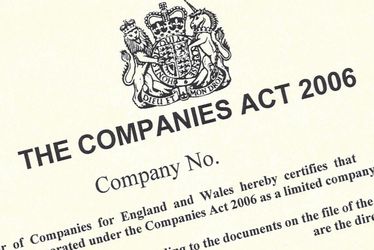
Christi Perou
In my dissertation I examine whether the principle of corporate social responsibility (hereinafter CSR)
is mirrored in section 172 of the Companies Act 2006 (hereinafter CA 2006). CSR means moving away
from shareholder wealth maximisation towards responsibility to a broader range of stakeholders.
Stakeholders can be defined as groups that are likely to be affected by the operation of a company,
for instance the shareholders, the employees, the consumers, the environment etc. In my dissertation
I will argue that nowadays CSR is used as a marketing strategy for ‘window dressing.’ S172 promotes
the principle of the enlightened shareholder value, ESV, which requires the directors, in promoting
the success of the company for the benefit of the members, namely the shareholders, to balance the
interests of various stakeholders mentioned in the provision. It was argued that ESV changed the
approach to corporate objective by introducing the requirement for directors to consider a variety of
interests other than those of shareholders. However, I will argue that the approach to corporate
objective did not change since the interests of shareholders still are supreme. Lastly, I will conclude
that the law is formed in such a way that compels directors to act first and foremost in the interests
of shareholders without leaving scope for CSR.

Christi Perou

What is corporate social responsibility (CSR)?
There is no single accepted definition for CSR. CSR might be defined as voluntary activities that large companies are engaging with in order to minimize their outcome to society. Such activities include philanthropy, minimizing environmental pollution, improving working conditions. CSR is endeavoring to address the externalities of companies to various stakeholders and is seeking a shift from shareholder wealth maximization to a balance of all stakeholders' interests. Note that even though CSR is promoting the balance of interests of stakeholders and shareholders there is no indication which stakeholder group’s interests are to prevail in cases of conflict of interest. Lastly, some of the most widely accepted characteristics of CSR include long term focus, reputation and voluntary.
Who are the stakeholders?
Anyone, not necessarily a human being, who can be affected by the operation of companies can be classified as a stakeholder. Stakeholders include, but are not limited to, employees, customers, shareholders, creditors, the community and the environment.
Stakeholders are important for a company since the latter cannot make a profit without the former. Employees are important since they are producing the goods that a company is selling, or they offer services to the clients. Customers are important too because if they do not buy a company's product or services then the latter cannot make a profit. CSR is dealing with the relationship of the company to stakeholders and the former is endeavoring to protect stakeholders' interests.

What is shareholder wealth maximization?
Shareholder wealth maximization is what most companies are endeavouring to achieve. This principle translates to the increase of profit for the company and shareholders. Note that when a company is increasing its profits then shareholders are increasing their profits too. However, shareholder wealth maximization is increasing profits on the expense of other stakeholders. That is why CSR is endeavouring to shift the focus off shareholder wealth maximization because the former is focusing on the interests of all stakeholders, not only shareholders’.

Csr’s definition depends on the lens:
It depends on the background and the lens of someone approaching this principle. For instance, usually, companies are using strategic CSR or CSR as a marketing strategy to increase profit. CSR as a marketing strategy is used for window-dressing by companies stating that they are CSR conscious even if they are not. Strategic CSR means companies are engaging in CSR activities to conceal their interests in shareholder wealth maximization and increase this profits in the long term. CSR nowadays is more of a trend for large companies since it is highly related to corporate reputation. However, there is also ethical CSR which is companies engaging in CSR activities voluntary without any financial interest.
Corporate lawyers tend to connect CSR with corporate governance. Corporate governance regulates how a company is governed, for instance, what are directors’ duties. It is questionable whether engagement in CSR activities is included in directors’ duties. Even though there is no piece of legislation mentioning the principle of CSR or guiding companies to engage in CSR activities it is argued that CSR is mirrored by section 172 (s172) of the Companies Act 2006 (CA 2006).

What are directors’ duties?
Directors’ duties are the duties that every director owes to a company and include, inter alia, the duty to promote the success of the company which is defined in s172 of the CA 2006. They owe such duties because in the eyes of law a company is a separate legal person, which means that it can sue and can be sued. Before examining the duty in s172 it is worth looking at the legal position before 2006.

The position before 2006:
Directors’ duties in general, before the enactment of the CA 2006, could be found in the common law. Common law is defined as the legal principles that derive from cases, not statutes. Before 2006 the courts were approaching the duty to promote the success of the company differently, depending on the facts of each case. This was confusing since there was no single approach as to what constitutes the success of the company. Usually, courts were interpreting the success of the company as the interests of its shareholders. However, in some cases, the success of the company was not defined as merely the interests of shareholders and included the interests of employees or creditors. Because of the confusion and the court’s amorphous approach to the duty to promote the success of the company it was decided to codify all directors’ duties in the CA 2006.

The introduction of s172:
The introduction of s172 was deemed to be confusing since the provision is vague. It does not provide adequate guidance to directors on how to discharge their duty, especially in terms of prioritising stakeholders’ interests in a conflict of interests scenario.

S172:
S172 provides that a directors’ duty is to promote the success of the company for the benefit of shareholders and in doing so, to have regard, inter alia, to the interests of various stakeholders. It is clear that the interests of shareholders are supreme since the director must have regard to the interests of stakeholders in discharging this duty. A director can consider the interests of stakeholders in a decision but he is not obliged to choose the decision that will benefit them. He/She must decide for the interests of shareholders and as long as these interests are promoted then consider the interests of stakeholders too.
S172 provides that the director must consider the interests of a list of stakeholders, which is not exhaustive, but no further guidance is provided as to the priority of each group of stakeholders. For example, it is provided that the interests of employees and customers should be considered but there is no indication which one is paramount. In cases of conflict of interest, s172 does not provide whose interests are to take priority.
Does s172 mirror CSR? Yes?
S172 provides for the consideration of the interests of stakeholders and as said CSR is promoting the balance of the interests of shareholders and stakeholders. S172 contains some of the characteristics of CSR which include the long term focus, the consideration of the interests of various stakeholders and a company's desirability to maintain a good reputation. At first blush, it might be argued that s172 mirrors the principle of CSR since it contains some of its basic characteristics.

Does s172 mirror CSR? Yes?
It might be argued that CSR is vague since, as said, there is no universally accepted definition. Also, because there is no guidance in terms of interest prevalence amongst stakeholders, CSR can be characterized as confusing. The same issue is spotted in relation to s172, since it does not provide guidance on whose interests, among stakeholders, are to be prioritised. It might be argued that s172 mirrors CSR indirectly since it has the same issue with interests prioritization. CSR does not provide whose interests are to prevail and thus, s172 does not either.
Does s172 mirror CSR? No?
Even though s172 contains some of the characteristics of CSR, it does not mirror the latter. CSR provides for a balance between shareholders’ and stakeholders’ interests. S172 though provides that the interests of shareholders are supreme, which contradicts with the idea of CSR. The key in s172 are the phrases ‘in doing so’ and ‘to have regard’ which imply that the director, in acting for the success of shareholders, in discharging his duty, has to consider the interests of stakeholders. However, there is no additional requirement for the director to promote the interests of stakeholders.

Does s172 mirror CSR? No?
S172 promotes strategic but not ethical CSR. The motive provided by s172 to companies to be, in a way, more socially responsible is reputation. Ethical CSR provides that companies are being socially responsible because they care about their impacts on society and they do not have any other goals, like increasing profit in long term. However, s172 provides indirectly for sort of strategic CSR.

Does s172 mirror CSR? No?
The fact that the interests of more stakeholders have been introduced by s172 in the decision-making process, does not mean that the director is obliged to promote them. S172 provides that the director must promote the success of the company for the benefit of the members, i.e. shareholders. In terms of the interests of stakeholders, s172 provides that the director must have regard, not promote them. Directors are obliged to promote the interests of shareholders, not stakeholders, which is contrary to the idea of CSR. According to s172 the interests of stakeholders must be considered, not promoted, as long as this benefits shareholders which is not compatible with CSR since the latter provides that balance between stakeholders' interests is key.
Slide 1 image (max 2mb)
Slide 1 video (YouTube/Vimeo embed code)
Image 1 Caption
Slide 2 image (max 2mb)
Slide 2 video (YouTube/Vimeo embed code)
Image 2 Caption
Slide 3 image (max 2mb)
Slide 3 video (YouTube/Vimeo embed code)
Image 3 Caption
Slide 4 image (max 2mb)
Slide 4 video (YouTube/Vimeo embed code)
Image 4 Caption
Slide 5 image (max 2mb)
Slide 5 video (YouTube/Vimeo embed code)
Image 5 Caption
Slide 6 image (max 2mb)
Slide 6 video (YouTube/Vimeo embed code)
Image 6 Caption
Slide 7 image (max 2mb)
Slide 7 video (YouTube/Vimeo embed code)
Image 7 Caption
Slide 8 image (max 2mb)
Slide 8 video (YouTube/Vimeo embed code)
Image 8 Caption
Slide 9 image (max 2mb)
Slide 9 video (YouTube/Vimeo embed code)
Image 9 Caption
Slide 10 image (max 2mb)
Slide 20 video (YouTube/Vimeo embed code)
Image 10 Caption
Caption font
Text
Image (max size: 2mb)
Or drag a symbol into the upload area
















Image description/alt-tag
Image caption
Image link
Rollover Image (max size: 2mb)
Or drag a symbol into the upload area
















Border colour
Rotate
Skew (x-axis)
Skew (y-axis)
Image (max size: 2mb)
Or drag a symbol into the upload area
















Image description/alt-tag
Image caption
Image link
Rollover Image (max size: 2mb)
Or drag a symbol into the upload area
















Border colour
Rotate
Skew (x-axis)
Skew (y-axis)
Image (max size: 2mb)
Or drag a symbol into the upload area
















Image description/alt-tag
Image caption
Image link
Rollover Image (max size: 2mb)
Or drag a symbol into the upload area
















Border colour
Rotate
Skew (x-axis)
Skew (y-axis)
Image (max size: 2mb)
Or drag a symbol into the upload area
















Image description/alt-tag
Image caption
Image link
Rollover Image (max size: 2mb)
Or drag a symbol into the upload area
















Border colour
Rotate
Skew (x-axis)
Skew (y-axis)
Image (max size: 2mb)
Or drag a symbol into the upload area
















Image description/alt-tag
Image caption
Image link
Rollover Image (max size: 2mb)
Or drag a symbol into the upload area
















Border colour
Rotate
Skew (x-axis)
Skew (y-axis)
Image (max size: 2mb)
Or drag a symbol into the upload area
















Image description/alt-tag
Image caption
Image link
Rollover Image (max size: 2mb)
Or drag a symbol into the upload area
















Border colour
Rotate
Skew (x-axis)
Skew (y-axis)
Image (max size: 2mb)
Or drag a symbol into the upload area
















Image description/alt-tag
Image caption
Image link
Rollover Image (max size: 2mb)
Or drag a symbol into the upload area
















Border colour
Rotate
Skew (x-axis)
Skew (y-axis)
Image (max size: 2mb)
Or drag a symbol into the upload area
















Image description/alt-tag
Image caption
Image link
Rollover Image (max size: 2mb)
Or drag a symbol into the upload area
















Border colour
Rotate
Skew (x-axis)
Skew (y-axis)
Image (max size: 2mb)
Or drag a symbol into the upload area
















Image description/alt-tag
Image caption
Image link
Rollover Image (max size: 2mb)
Or drag a symbol into the upload area
















Border colour
Rotate
Skew (x-axis)
Skew (y-axis)
Image (max size: 2mb)
Or drag a symbol into the upload area
















Image description/alt-tag
Image caption
Image link
Rollover Image (max size: 2mb)
Or drag a symbol into the upload area
















Border colour
Rotate
Skew (x-axis)
Skew (y-axis)
Image (max size: 2mb)
Or drag a symbol into the upload area
















Image description/alt-tag
Image caption
Image link
Rollover Image (max size: 2mb)
Or drag a symbol into the upload area
















Border colour
Rotate
Skew (x-axis)
Skew (y-axis)
Image (max size: 2mb)
Or drag a symbol into the upload area
















Image description/alt-tag
Image caption
Image link
Rollover Image (max size: 2mb)
Or drag a symbol into the upload area
















Border colour
Rotate
Skew (x-axis)
Skew (y-axis)
Image (max size: 2mb)
Or drag a symbol into the upload area
















Image description/alt-tag
Image caption
Image link
Rollover Image (max size: 2mb)
Or drag a symbol into the upload area
















Border colour
Rotate
Skew (x-axis)
Skew (y-axis)